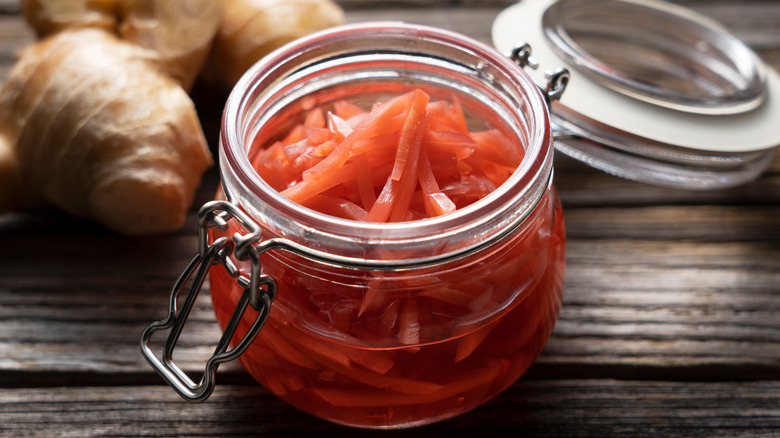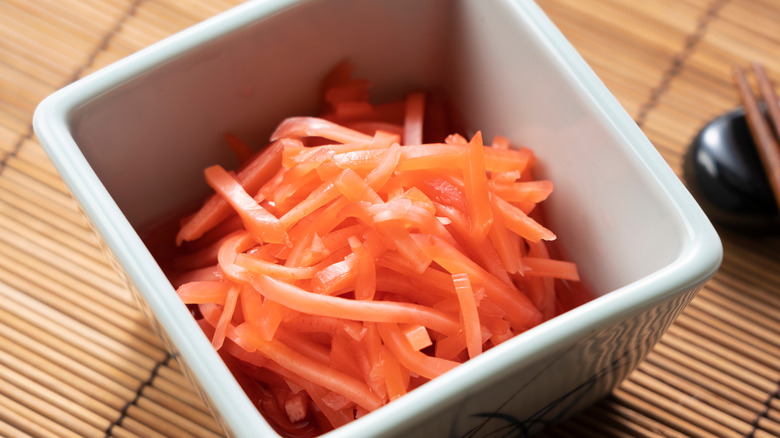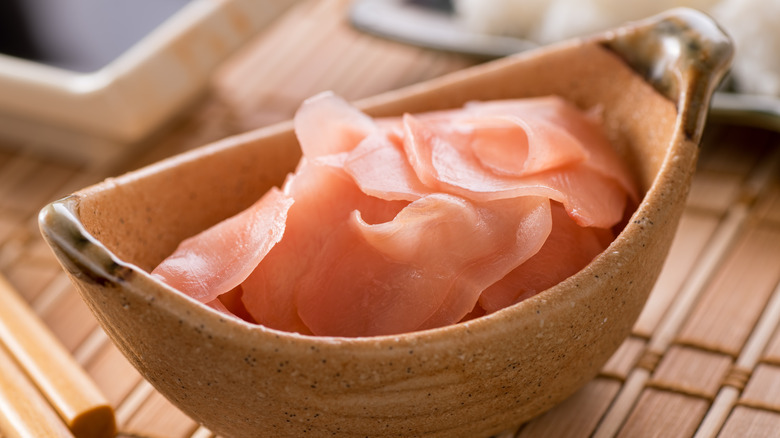The Major Flavor Difference Between Beni Shoga And Gari Ginger
At a glance, beni shoga and gari ginger might seem like different cuts of the same thing — both are Japanese pickled ginger pieces, dyed pink and served alongside other dishes. Due to the fact that they're used as a garnish for very different genres of dishes and almost never served side by side, you might not have noticed that these two types of pickled ginger actually have a major flavor difference. While they both have that sharp burn of pickled ginger, the thin strips of beni shoga have a sour and tart taste while sliced gari ginger has a much sweeter profile.
The difference comes down to the liquids they are pickled in. Beni shoga ginger is made from umeboshi vinegar, a tangy fruit and salt liquid made from ume plums. Gari ginger, known as sushi ginger, on the other hand, is pickled in a mixture of rice vinegar and sugar. The much more mellow taste of rice vinegar brings the sugar to the forefront to leave the gari ginger with its signature sweetness.
What is beni shoga ginger?
You'll recognize beni shoga ginger as the bright magenta-pink garnish on hearty and savory Japanese dishes. While it's often artificially dyed when commercially produced, beni shoga traditionally gets its vivid color from the rich red of umeboshi vinegar — which, in turn, owes its color to the red perilla leaves it's infused with. Umeboshi vinegar is actually the byproduct of pickling ume plums into umeboshi, which is a popular tsukemono (Japanese pickled side dish) in its own right. The sour ume plums are pickled in a dry covering of salt and red perilla leaves, which then results in the dried umeboshi and the byproduct. This is also known as umezu and isn't technically vinegar, but a salty and sour pickling liquid.
If you want to go the homemade route, the process of making beni shoga entirely from scratch is actually quite simple and manageable. The only ingredients involved are ginger and umezu: You cut up the ginger, boil the pieces to soften them up, then pack them in your pickling container of choice with the umezu and leave them in the fridge for a few days. The resulting sharp and acidic flavor is perfect for cutting into rich flavors. Along with the natural digestion-aiding properties of ginger, this is why you'll see beni shoga most often paired with delicious but greasier dishes like beef-based gyudon, yakisoba fried noodles, and the savory vegetable pancakes okonomiyaki.
What is gari ginger?
Ranging in color anywhere between neon pink and naturally off-white, gari ginger is the standard complement to sashimi and sushi dishes. Like beni shoga, there is a natural reason why traditionally made gari can be pink: Ginger naturally has color pigments that can be activated during the pickling process. The younger the ginger is, the more likely it'll turn out a pretty soft pink after pickling — however, it's worth noting that a soft pink is as colorful as it'll ever get, and anything more saturated than that has likely been artificially dyed.
Unlike the two-ingredient recipe of beni shoga, gari takes a few more components and steps to make at home. The main difference is that you'll need to make the pickling brine yourself by boiling sugar and vinegar water together. Another thing to keep in mind is that gari ginger is usually left to sit with some salt after being cut and before pickling to draw out the moisture. Finally, you'll need to be pickier about your pickling container because you'll be pouring hot brine in with the ginger.
Other than that, however, the general process is the same: Cut, blanch, then soak the ginger, and leave refrigerated until ready. With its sweeter and milder flavors, this sushi accompaniment isn't too harsh on the taste buds. In fact, gari ginger should be eaten as a palate cleanser between trying different kinds of sushi and sashimi.


